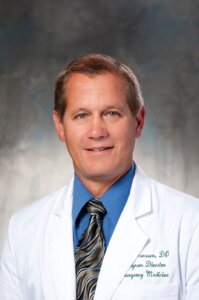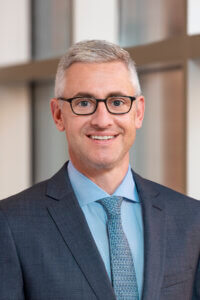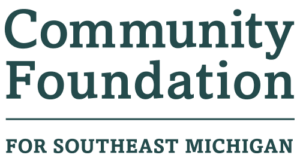
Ascension Genesys Hospital Addresses Stigma and Offers Dual-Pronged Treatment through its Emergency Department
As one of the leading nonprofit health systems in the United States, Ascension is committed to delivering compassionate, personalized care to all with a special emphasis on those who are most vulnerable. Also reflected in the organization’s mission is to advocate for a more just and compassionate society in words and actions.
These guiding principles were the basis for Ascension Genesys Hospital’s decision to apply for funding from the Community Foundation for Southeast Michigan to enhance their work with people with opioid use disorder (OUD).
“Our involvement with the Michigan Opioid Partnership through the foundation allows us to focus on this issue in a collective and systemic way,” says Sue Tippett, director of grants administration at Ascension Genesys Hospital in Grand Blanc, Michigan. “The funding helps to advance our work in this area more quickly and comprehensively.”
Outpatient and Inpatient Resources for Opioid Use Disorder Treatment

Dr. Alan Janssen
With the number of opioid-related deaths exceeding 400,000 nationally and rising, staff at Genesys could not overlook the impact the epidemic had on patients. “We have this horrible situation where people are coming in every single day with overdose symptoms,” explains Dr. Alan Janssen, emergency room medical director at Ascension Genesys Hospital. “Opioid use has grown into such a problem; we couldn’t sit by and do nothing.”
Unless those with opioid use disorder presented with an active medical issue that could be diagnosed and treated, the emergency department could offer little to people in overdose or asking for assistance with mitigating their drug use.
“The best we could do was give them a piece of paper with resources on it and tell them to try those places,” says Dr. Janssen. “It’s not enough for these folks. They’re going to need their substance again before they can get help. We had to do better for these patients.”
Doing better took the form of a dual-pronged medication treatment program that offers outpatient and inpatient services.
On the outpatient side, once a person is determined to be suffering from OUD, the doctor prescribes buprenorphine or Suboxone to ease their withdrawal symptoms. “The medication takes away the cravings and increases the likelihood they will seek help,” says Dr. Janssen. The medical team determines if they have any other underlying health issues and assesses their interest in treatment.
Genesys brings in community care navigators from New Paths, a Flint-based center that works with an array of partners to address OUD, if the patient wants to pursue recovery. Upon discharge, the navigators (peer recovery coaches) help ensure the patient returns to the hospital daily for Suboxone treatment for three days until they are placed in a treatment center. “The person feels more supported as they start on the road to recovery if we can make a warm connection at the front end,” according to Dr. Janssen.

Dr. Michael Danic
Dr. Michael Danic, chairman of anesthesia at Ascension Genesys Hospital, leads the inpatient component of the medication treatment program.
“Massive gaps of care existed on the inpatient side,” says Dr. Danic. “Patients were just given benzodiazepines or narcotics to make sure they don’t go through withdrawals, then discharged. We had increased readmissions, decreased satisfaction, and weren’t addressing the disease.”
The process has since been revised so that when a person presents with OUD, a message is sent to a team of physicians, medical students, nurses, and pharmacists. They conduct a full consultation to determine the patient’s condition and willingness to undergo treatment. “If they are interested, we engage a peer recovery coach and start Suboxone,” Dr. Danic continues. “Once the disease process is taken care of, we coordinate a discharge plan to an outpatient setting to continue medication management.”
While Genesys considers the outpatient and inpatient initiatives integral to its OUD response, Community Foundation funds support the emergency department’s work. The two programs share resources such as peer recovery coaches, and Dr. Danic and Dr. Janssen collaborate on designing outpatient rehabilitation and home care plans in partnership with the hospital’s case managers. The grant also covers training for emergency physicians, nurses, and social workers to help them recognize who might be suffering from opioid use disorder and connect them with existing community resources.
“One of the biggest issues is that people with the disease don’t know about what’s available,” says Dr. Danic.
It Takes a Village
Genesys recognized the importance of assembling a multidisciplinary team to implement and sustain its MOUD programs. Dr. Danic emphasizes the importance of having representatives from various departments within the hospital act as program champions. Dr. Janssen and he are supported by nurses, nurse practitioners, and project coordinators who develop training protocols for subject matter experts in the emergency department, drug policy experts, and pharmacists.
“The more people you have bringing passion and expertise to the work, the easier it is to hold staff accountable and set up structures to monitor success,”says Dr. Michael Danic, inpatient treatment at Ascension Genesys Hospital.
Interacting with the next generation of pharmacists and physicians can also be helpful. “It prevents them from developing biases or prescribing to stigmas commonly held by their predecessors,” he continues.
Dr. Janssen echoes Dr. Danic’s comments, reiterating the importance of involving professionals outside of the hospital, including coaches and counselors to “help bridge people with OUD from either the outpatient or inpatient sides for long-term benefit.”
Addressing the Stigma Around Opioid Use Disorder
Dr. Danic describes people with OUD as “extremely complex patients who often have codependency and psychosocial issues and may also suffer from depression and comorbidities.” Additionally, the disease can be exacerbated by other vulnerabilities such as exposure to trafficking, sexual assault, and domestic violence.
Trauma surfaces negative personality traits, making some OUD patients manipulative, combative, or even abusive. It can also lead to repeated patterns of use. Dr. Danic believes these characteristics contribute to the stigma associated with OUD and the people who suffer from it.
Since the onset, the program’s champions have encountered bias-based resistance to treating OUD patients. Doctors, nurses, and family members alike are resistant to seeing OUD as a disease. According to Dr. Danic, “They lose patience and tolerance because of the difficulty in dealing with these patients. We have to treat them with the same compassion and love as those with other chronic conditions who don’t always follow medical advice.”
The culture in the emergency department is that patients have done this to themselves, and their conditions are choice-driven. Dr. Janssen recalled when a colleague told him to be wary of turning the department into an opioid recovery center. “A lot of doctors aren’t well educated about OUD and don’t see it as a medical disorder like diabetes or high blood pressure. They are afraid to reach out. They don’t want to help these patients,” he says.
Reversing stigma is the keystone of Genesys’s entire project and was an important point of conversation during program design. “Training factors so prominently in our work because the smarter the hospital’s subject matter experts are about OUD and MOUD, the more empathy they’ll display to these patients,” says Tippet. Using materials and insights from programs around the country, Genesys’s project coordinators are developing a curriculum that educates doctors and other staff about the causes and symptoms of OUD. Related myths, trauma-informed care, and medication for opioid use disorder as the best treatment protocol are among the topics covered in the teachings.
Beyond education, Dr. Danic says leading by example is another way to combat stigma. “You have to be willing to put in the work and do the right thing by the patient even when it’s hard,” he says. Equally important is frequent communication, reminding staff that they are treating disease, not a social phenomenon.
“We have to make sure our team stays motivated and knows they have support to make a difference with this patient group,” says Dr. Michael Danic, inpatient treatment at Ascension Genesys Hospital.
Wins and Lessons Learned
One of the unfortunate realities helping Genesys overcome stigma is the disease’s prevalence in the news and people’s lives. The doctors and nurses working on the project are among the vast number of individuals dealing with opioid use disorder within their circle of family and friends. The training component of the program is also giving them the knowledge and confidence to approach and deal with disease sufferers appropriately.
Harm reduction and bridging the gap between inpatient and outpatient treatment are additional wins, according to Dr. Danic and Dr. Janssen. “Being able to manage withdrawal symptoms means people are willing to stay in treatment longer and are not leaving the hospital to get high. Their chances for recovery improve,” says Dr. Danic.
Dr. Janssen points out that Genesys has “been able to provide families with Naloxone in case of relapse, and it’s saved lives. We’ve seen real-time changes and positive aspects of the program we’ve rolled out.”
While both doctors say it is difficult to quantify the financial benefits to Genesys at this point, Dr. Danic suggests the hospital is likely seeing a decrease in readmissions. Dr. Janssen mentions that the medication treatment programs are helping the institution meet its mission. “The hospital is committed to improving community services, and I think this is a huge step in that direction,” he says.
